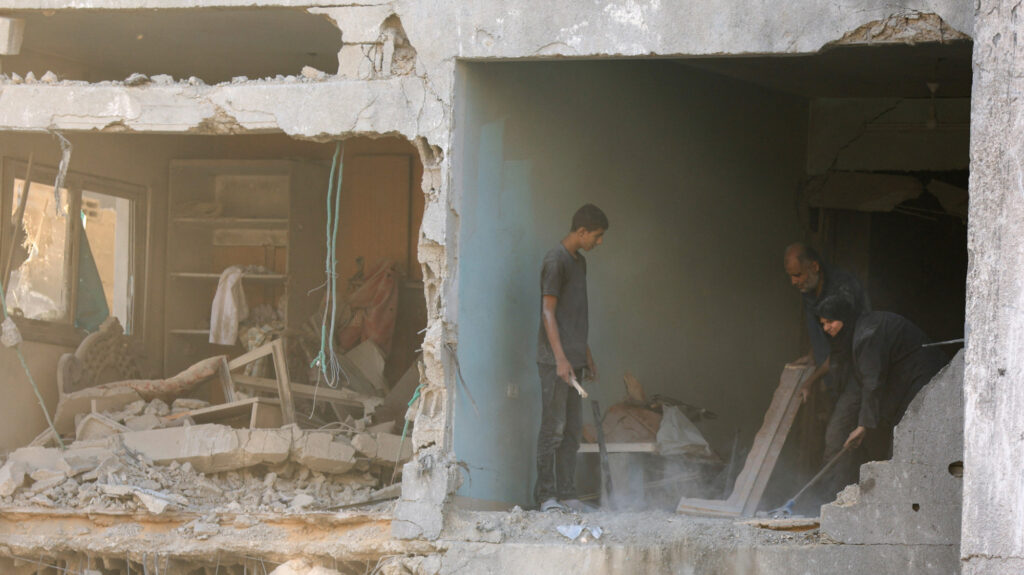Palestinians in Gaza City who resist expulsion under relentless Israeli bombardment are now being forced out by a quieter weapon: the destruction of their means of survival.
As part of an officially declared plan to ethnically cleanse Gaza City of its one million residents, the Israeli military has been heavily bombing vital lifelines since mid-August.
This has included high-rise buildings, schools sheltering thousands of displaced Palestinians, water tanks, rooftop solar panels, internet access points, and mobile charging stations.
“I had decided to stay and not leave, whatever happened,” said Emad Sarsawi, 43.
“For months, I used to say that I was willing to die with my wife and children in our home rather than be displaced again to the south. But what is happening is more dangerous than just death,” he told Middle East Eye.
New MEE newsletter: Jerusalem Dispatch
Sign up to get the latest insights and analysis on
Israel-Palestine, alongside Turkey Unpacked and other MEE newsletters
“Yesterday, the Israeli occupation bombed our neighbours’ building, which had solar panels on the roof. These panels were a lifeline for many residents in the neighbourhood. We relied on them to pump water and recharge our devices.”
Sarsawi explained that following the bombing of the solar panels, multiple families had no choice but to head south.
“If we were bombed, we would all be killed at once. But like this, we can’t even find drinkable, or even undrinkable, water, and we’ll die slowly of thirst,” he added.
“We also won’t be able to recharge our devices, which means total blackout. We won’t even know what’s going on around us.”
‘Like this, we can’t even find drinkable, or even undrinkable, water, and we’ll die slowly of thirst’
– Emad Sarsawi, Gaza City resident
Since the beginning of its genocide in Gaza in October 2023, Israel has cut off water and electricity, bombed internet infrastructure, and blocked fuel from entering the besieged enclave.
As a result, the Strip has been pushed into a state of famine, with its 2.2 million residents enduring complete blackouts on several occasions over the past 23 months.
Last month, Israel approved a plan to occupy the Gaza Strip, starting with the seizure of Gaza City.
Since then, Israeli forces have destroyed hundreds of housing units and killed more than 1,800 people.
Overall, Israeli forces have killed more than 64,800 Palestinians and wounded 164,000 since the war began. Over 80 percent of those killed are civilians, according to leaked Israeli military data.
After a month of heavy bombardment, a ground invasion of Gaza City is now the next move, according to Israeli media.
The challenge remains the hundreds of thousands of civilians who refuse to leave, citing the lack of safety anywhere else in the Gaza Strip.
Phone charging points targeted
In the absence of household electricity, a makeshift profession has emerged in Gaza’s streets: device charging points.
These are usually owned and managed by individuals or families with solar panels that generate enough electricity to recharge dozens of devices.
At these points, residents typically recharge their mobiles, tablets and laptops for 1–5 Israeli shekels ($0.33–$1.66).
But in recent days, Israeli forces have increasingly targeted these points across Gaza City.
Ahmed Ubeid, a displaced man sheltering in a school on al-Thawra Street in central Gaza City, said he once relied on one such point.
“A few days ago, a building was bombed in our neighbourhood and we thought it was the target, but they only hit the ground floor, where a neighbour’s charging point was,” said Ubeid, 26.
“The next morning, another neighbour who owned a similar point shut it down, fearing he too would be targeted for providing this service.”
Ubeid now has to walk long distances to recharge his and his family’s phones.
“I believe this is a reason why many, especially displaced people already living in tents, choose to relocate to places with better access to such services,” he said.
“But because relocation is so costly and difficult, they decide to do it once, moving southward, instead of staying in Gaza City, where they know they will be forced out again.”
Bombing schools-turned-shelters
Ubeid is even more concerned about the Israeli military’s accelerating strategy of forcing hundreds of thousands of displaced Palestinians out of schools by bombing them.
Over the past week, Israeli forces issued expulsion orders to multiple schools-turned-shelters, mainly in the Tal al-Hawa neighbourhood in southwest Gaza City, to clear the area.
‘They are shutting down every service that keeps a human alive to empty entire neighbourhoods en masse’
– Ahmed Ubeid, displaced Palestinian
“I have stayed in this school with my family since we were displaced from our neighbourhood in Shujaiya at the beginning of the war. We witnessed the ground invasion here and endured the first and second starvation,” Ubeid said.
“It has been over a year and a half, and this has become our home. We have nowhere else to go if they issue an evacuation order here. All schools in the central and southern Gaza Strip are already overcrowded. There is no place to set up a tent, even in the streets.”
By forcing these schools to close, the Israeli military is not only displacing people again but also cutting off vital resources for surrounding residential buildings.
For nearly two years, these schools have supplied residents with power to pump water into their buildings, while most relied on them for drinking and washing water otherwise unavailable in their homes.
“It is clear that they are cutting us off from main resources so that those who don’t comply with displacement orders will die of thirst, or bleed to death after being injured because they cannot power their phones to call for help,” Ubeid said.
“They are shutting down every service that keeps a human alive to empty entire neighbourhoods en masse.
“Those who insist on staying suddenly find themselves alone and doubting their decision.”


